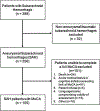Severe cognitive impairment in aneurysmal subarachnoid hemorrhage: Predictors and relationship to functional outcome
- PMID: 32807442
- PMCID: PMC7438604
- DOI: 10.1016/j.jstrokecerebrovasdis.2020.105027
Severe cognitive impairment in aneurysmal subarachnoid hemorrhage: Predictors and relationship to functional outcome
Abstract
Background: Cognitive impairment is common after aneurysmal subarachnoid hemorrhage (SAH). However, compared to predictors of functional outcome, meaningful predictors of cognitive impairment are lacking.
Objective: Our goal was to assess which factors during hospitalization can predict severe cognitive impairment in SAH patients, especially those who might otherwise be expected to have good functional outcomes. We hypothesized that the degree of early brain injury (EBI), vasospasm, and delayed neurological deterioration (DND) would predict worse cognitive outcomes.
Methods: We retrospectively reviewed SAH patient records from 2013 to 2019 to collect baseline information, clinical markers of EBI (Fisher, Hunt-Hess, and Glasgow Coma scores), vasospasm, and DND. Cognitive outcome was assessed by Montreal Cognitive Assessment (MoCA) and functional outcomes by modified Rankin Scale (mRS) at hospital discharge. SAH patients were compared to non-neurologic hospitalized controls. Among SAH patients, logistic regression analysis was used to identify predictors of severe cognitive impairment defined as a MoCA score <22.
Results: We screened 288 SAH and 80 control patients. Cognitive outcomes assessed via MoCA at discharge were available in 105 SAH patients. Most of these patients had good functional outcome at discharge with a mean mRS of 1.8±1.3. Approximately 56.2% of SAH patients had MoCA scores <22 compared to 28.7% of controls. Among SAH patients, modified Fisher scale was an independent predictor of cognitive impairment after adjustment for baseline differences (OR 1.638, p=0.043). MoCA score correlated inversely with mRS (r=-0.3299, p=0.0006); however, among those with good functional outcome (mRS 0-2), 48.7% still exhibited cognitive impairment.
Conclusions: Severe cognitive impairment is highly prevalent after SAH, even among patients with good functional outcome. Higher modified Fisher scale on admission is an independent risk factor for severe cognitive impairment. Cognitive screening is warranted in all SAH patients, regardless of functional outcome.
Keywords: Cognitive impairment; Delayed neurological deterioration; Fisher scale; Functional outcome; Montreal cognitive assessment; Subarachnoid hemorrhage.
Copyright © 2020 Elsevier Inc. All rights reserved.
Conflict of interest statement
Declaration of Competing Interest None.
Figures



References
-
- Johnston SC, Selvin S, Gress DR. The burden, trends, and demographics of mortality from subarachnoid hemorrhage. Neurology 1998;50(5):1413–1418. - PubMed
-
- Rincon F, Rossenwasser RH, Dumont A. The epidemiology of admissions of nontraumatic subarachnoid hemorrhage in the united states. Neurosurgery 2013;73(2):217–222; discussion 212–213. - PubMed
-
- Suarez JI, Tarr RW, Selman WR. Aneurysmal subarachnoid hemorrhage. N Engl J Med 2006;354(4):387–396. - PubMed
-
- Kreiter KT, Copeland D, Bernardini GL, et al. Predictors of cognitive dysfunction after subarachnoid hemorrhage. Stroke 2002;33(1):200–208. - PubMed
-
- Taufique Z, May T, Meyers E, et al. Predictors of poor quality of life 1 year after subarachnoid hemorrhage. Neurosurgery 2016;78(2):256–264. - PubMed
MeSH terms
Grants and funding
LinkOut - more resources
Full Text Sources
Medical

